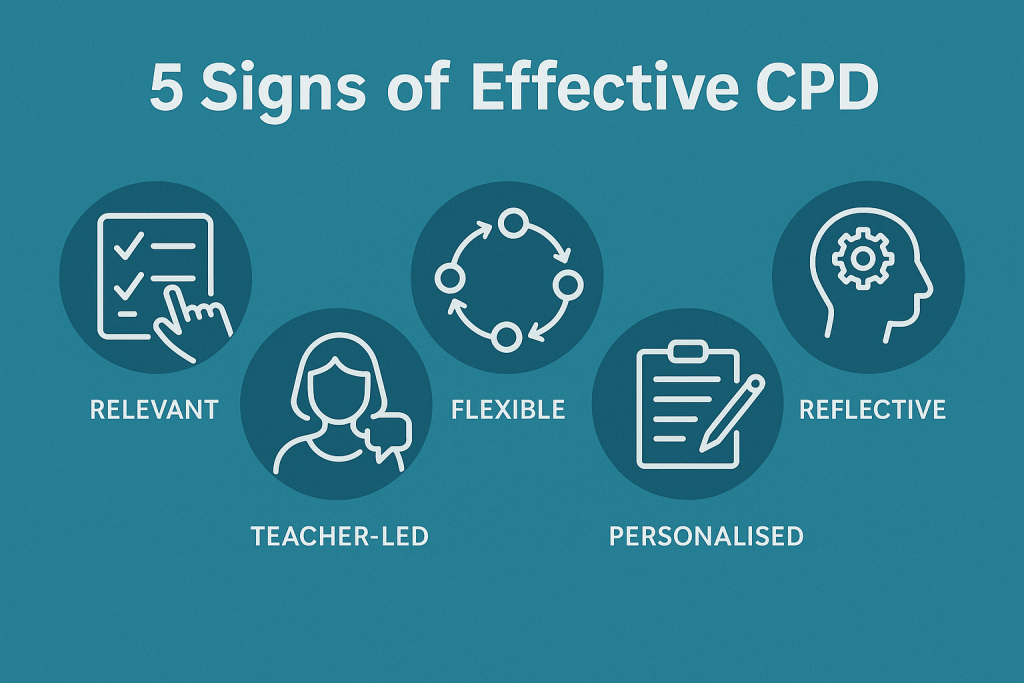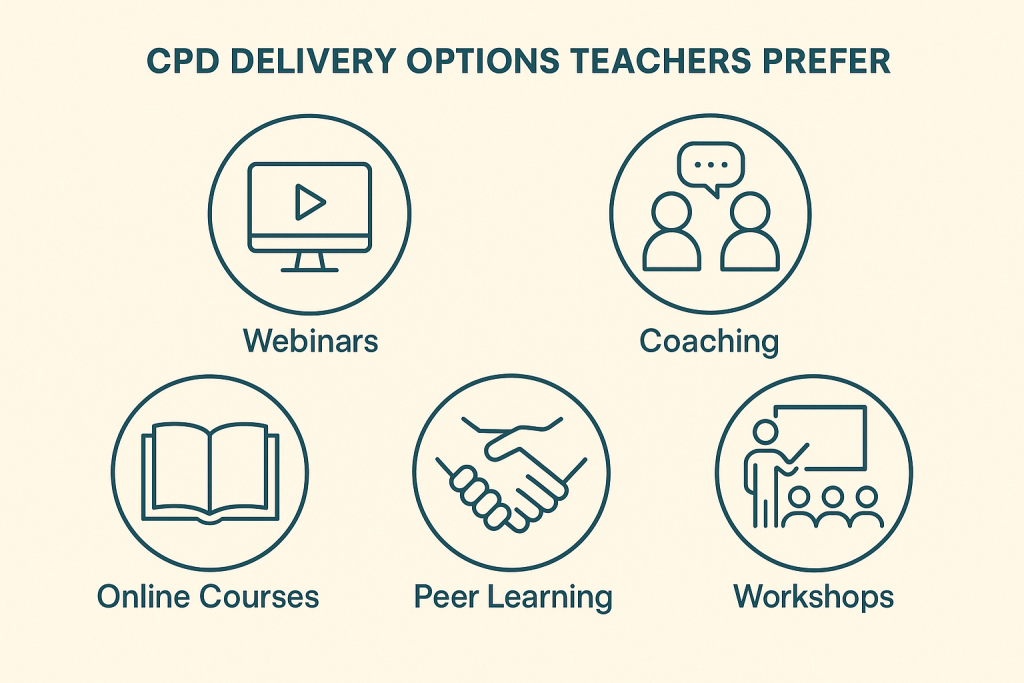Professional development should feel like a pathway, not a box to tick. Yet for many educators, CPD often arrives as a top-down, one-size-fits-all experience that feels detached from real classroom needs. Whether it’s a rushed workshop with little follow-up or generic content that misses subject-specific challenges, the impact can be limited, and so can teacher motivation.
But CPD done well can be transformative. A well-designed CPD plan gives teachers agency, relevance, and time to grow. It supports student outcomes, strengthens school culture, and builds trust among staff. In our latest guide, we explore what educators actually want from professional development, and how schools can craft CPD experiences that are practical, personalised, and genuinely impactful.
Understanding What Teachers Need from CPD
A Focus on Relevance and Application
One of the most common frustrations among teachers is CPD that feels disconnected from the realities of the classroom. Educators want professional development that speaks directly to the subjects they teach, the challenges they face, and the learners they support. A CPD session on generic theory may tick a box, but unless it helps teachers improve practice tomorrow, its value is limited.
Effective CPD plans start with a teacher’s voice. Surveys, interviews, or informal staffroom conversations can reveal pressing topics, like managing inclusive classrooms, using new edtech tools, or supporting student wellbeing. When CPD is tailored to real needs, engagement increases, and the impact is more immediate.
Respecting Time and Workload
Teachers are busy, and their time is precious. CPD that adds to their workload without offering clear value can quickly feel like a burden. That’s why flexibility and clarity are essential. Whether it’s a short, high-impact workshop during a staff meeting or an online module completed during planning periods, professional development must be thoughtfully scheduled and manageable.
Schools that integrate CPD into existing rhythms, like collaborative planning time or mentoring sessions, tend to see higher participation and better outcomes. The key is to honour teachers’ time while still prioritising growth.

Building Flexibility into the Plan
No two teachers learn the same way, and a strong CPD plan reflects that. Some educators prefer in-person workshops where they can ask questions in real time, while others thrive with asynchronous online modules they can complete at their own pace. Offering a mix of delivery methods, ranging from webinars, coaching, to peer-led sessions, gives teachers ownership over how they engage with professional learning.
Opportunities for Personalised Pathways
Teachers are at different stages in their careers, with varying goals and specialisations. Effective CPD planning goes beyond one-size-fits-all sessions and instead encourages choice. Whether it’s a pathway in subject leadership, inclusion strategies, or integrating STEM, a flexible framework helps educators pursue the skills that matter most to them and their students. Some schools even use micro-credentials or digital portfolios to support these individualised tracks.

Prioritising Relevance and Real Impact
Connected to Classroom Practice
Professional development is most powerful when it translates directly into better teaching and learning. Teachers value CPD that addresses the real challenges they face in their classrooms—whether that’s differentiating for mixed-ability groups, using technology effectively, or managing student wellbeing. Relevant training should feel actionable, not theoretical.
Grounded in Student Outcomes
The ultimate goal of CPD is to improve student learning. Strong plans draw a clear line between what teachers are learning and how it will benefit their students. For example, training on formative assessment should include strategies for providing more meaningful feedback or adjusting instruction to meet learner needs. When teachers can see the connection, they’re far more likely to engage deeply.
Choice, Flexibility, and Teacher Voice
Teachers bring a wide range of experiences, goals, and subject expertise to their professional development. Effective CPD plans recognise this by offering flexibility. That could mean allowing teachers to select from a menu of workshops, pursue micro-credentials, or engage in peer-led initiatives aligned with their interests and roles.
Involving Educators in Planning
When teachers are involved in shaping CPD priorities, the outcomes are often more meaningful. Surveys, focus groups, or staff-led CPD committees help ensure development opportunities reflect real needs. This bottom-up approach also encourages buy-in and cultivates a shared sense of purpose across the school.
Led by Educators, Not Just Experts
Peer-Led Learning Builds Ownership
When professional development is led by fellow teachers, it often feels more relevant and grounded in the realities of the classroom. Educators bring credibility, empathy, and practical insight that outside trainers may lack. This can take the form of peer coaching, internal workshops, or teacher-led learning walks.
Valuing Internal Expertise
Schools are full of untapped knowledge. From seasoned staff mentoring new hires to tech-savvy teachers leading sessions on digital tools, recognising and elevating internal expertise builds community and reinforces the message that every educator has something to contribute.
Aligned with Individual Goals and School Needs
Great CPD plans strike a balance between what the school needs and what teachers want. While whole-school initiatives (like inclusive education or curriculum alignment) are essential, teachers are more engaged when they also get to explore areas they’re personally passionate about, whether that’s outdoor learning, STEM integration, or assessment strategies.
Using Appraisals to Inform Planning
When done well, performance reviews can be a helpful foundation for CPD planning. They offer insight into where teachers feel confident, where they want support, and how their goals align with school development plans. This makes CPD more targeted, meaningful, and sustainable over time.
Measurable, Reflective, and Ongoing
Focus on Growth, Not Just Hours
The most impactful CPD plans are not measured by how many workshops a teacher attends but by the progress they make in their classroom practice. Good plans include clear objectives and space for teachers to evaluate what’s working, and what’s not.
Encouraging Ongoing Reflection
Reflection should be woven into the CPD process, not left until the end of the year. Whether through peer feedback, teaching journals, or coaching conversations, regular check-ins help teachers stay on track and adapt their goals as needed. This reflective loop ensures professional growth is continuous and practical.
Supported by School Culture and Leadership
A strong CPD plan starts at the top. When school leaders model a commitment to ongoing learning and allocate meaningful time and resources to staff development, it sends a clear message that growth is a priority. This support can come in the form of coaching programmes, allocated planning time, or access to external experts.
Moreover, great CPD doesn’t happen in isolation. Schools that embed professional learning into the everyday fabric of teaching, through peer observation, shared planning, and open dialogue, create a culture where teachers learn from one another. When educators feel safe to experiment and reflect together, development becomes more authentic and impactful.
Final Thoughts on Building CPD that Matters
A strong CPD plan is not about ticking boxes, it’s about creating meaningful opportunities for teachers to grow in ways that directly impact their students. When professional development is responsive, collaborative, and backed by leadership, it becomes a genuine driver of school improvement.
For curated resources, expert guidance, and tools to support your school’s professional learning journey, visit AISL Mall.










